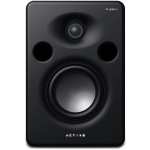Alesis M1 MKIII Active Studio Monitor Overview
Full Description
Extended Frequency Response
The Alesis M1 Active MKIII Active Studio Monitor includes both a 5-inch aluminium low-frequency driver and a 1-inch silk dome tweeter, with optimised front-firing ports for an extended low-frequency response. The bi-amplified design provides an extended frequency response ranging from 45Hz-22kHz, covering the full musical spectrum, ideal for mixing and mastering applications. The result is powerful and highly accurate sound reproduction, capturing every nuance of your source audio as it was intended.
Exceptional Accuracy
The Alesis M1 Active MKII Studio Monitor features a range of premium-quality components that result in exceptional sonic accuracy and audio fidelity. One of the most unique features is the computer-optimised tweeter waveguide for precise imaging, producing a widened ‘sweet spot’ for optimal accuracy. The new 5-inch aluminium woofer is also lighter and stiffer than typical carbon-fibre, paper or glass-Aramid woofers, ensuring a faster transient attack and linear response through the midrange and bass bands.
Design & Connectivity
The sleek yet robust design is smoothly radiused for an aerodynamic cabinet edge that prevents audible artifacts from edge diffraction and the front-firing bass ports eliminate port turbulence from the speaker’s bass output for increased clarity and audio performance. The Alesis M1 MKII Monitor also includes a balanced XLR and 1/4-inch combo input for flexible connectivity, allowing you to hook up all of your studio equipment with ease.
What’s Included
- M1 Active MK3 Studio Monitor
- Power Cable
- User Guide
- Safety and Warranty Manual
Features
- 65W (40 LF, 25 HF) Bi-amplified design for powerful, accurate sound
- 5” aluminum low-frequency driver; 1” silk dome tweeter
- New computer-optimized tweeter waveguide for precise imaging
- Optimized front-firing ports for extended low-frequency response
- Balanced XLR+1/4” combo input for complete hookup flexibility
- Ultra-wide 45-22kHz frequency response covers full musical spectrum












